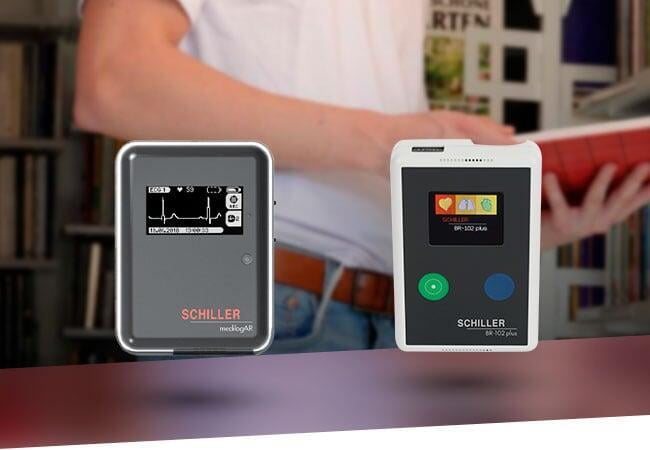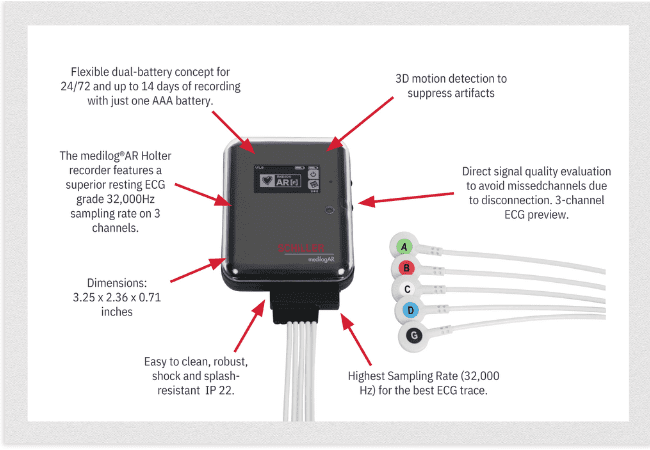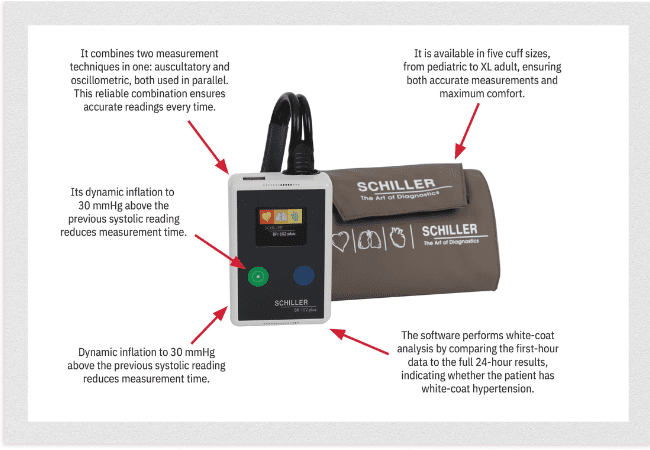By América Torres
Ambulatory monitoring devices, such as Holter and ABPM, collect and analyze long-term data. This facilitates the early detection of significant physiological events because if this test yields timely alerts, the cardiologist can act quickly and precisely. The popularity of ambulatory monitoring among healthcare professionals has ushered in a new paradigm in cardiac healthcare. In this article, we will delve into the details of this valuable tool, which is crucial for continuous long-term monitoring and the diagnosis of cardiac diseases.
What is a Holter monitor?
The holter monitor was introduced to the market in 1963, and since then, there has been an evolution leading to the development of increasingly smaller recorders, progressing from 1 to 12 channels. After continuous improvements and advances, the Holter is now the size of a small cell phone and provides two types of primary data for analysis. One is the QRS complex, and the other is the R-R interval. Conventional Holters record continuously until detached from the patient or run out of power, although the standard monitoring time is 24-48 hours. We cannot overlook that the Internet, Wi-Fi, and broadband transmission, among other advancements, have brought the Holter monitor into the current digital era.
What is ABPM?
ABPM stands for Ambulatory Blood Pressure Monitor. The first person to measure blood pressure (BP) levels was Stephen Hales in 1733 by inserting a glass tube into a horse's artery. Hales observed that the blood "would rise and fall at and after each pulse by 2, 3 or 4 inches." Although this observation has been overlooked since then, it not only signifies the pulsatility of blood flow but also indicates the variable nature of BP levels.
ABPM refers to recording blood pressure, usually over 24 hours, to observe pressure variability patterns. This monitoring provides a superior and more precise assessment of accurate BP than standard one-time measurement. ABPM can detect circadian changes (diurnal rhythmic changes, including nocturnal dipping and morning surge) and BP variation in response to environmental and emotional changes experienced by the patient.
In addition, ambulatory blood pressure monitoring is a valuable tool for assessing the effect of antihypertensive therapy and predicting cardiovascular outcomes. Blood pressure is recorded every 15-30 minutes over the entire 24-hour. According to the 2017 ACC/AHA guidelines, a normotensive patient should have daytime ABPM <120/80 mm Hg and nighttime ABPM <100/65 mm Hg. Although ABPM can detect fine changes in BP variation in the circadian rhythm, the clinical significance of BP variability other than diurnal variation (such as beat-to-beat variation) remains uncertain.
Clinical relevance. In clinical practice, ambulatory blood pressure monitoring has diagnostic, prognostic, and therapeutic utility. Therefore, it remains the gold standard for diagnosing hypertension, including white coat, masked, and nocturnal hypertension. Ambulatory BP has been known to help start the treatment of hypertension in patients with differential cardiovascular risks, including low-risk patients with white coat hypertension, or with high risk, including sustained hypertensive patients.
Other indications may include screening for obstructive sleep apnea, and in patients with postprandial heart rate variability and hypotensive symptoms, to rule out autonomic malfunction. For patients on treatment for hypertension, it can help monitor antihypertensive therapy, development of hypotensive symptoms on treatment, drug resistance, and correlation with office BP readings.
Now that we have discussed the clinical utility of these tools, it's time to delve into the lightweight, comfortable, and powerful ambulatory monitoring tools that SCHILLERhas developed.
medilog® AR Holter
The medilog® AR Holter is an advanced, efficient, and reliable device. That's why it's perfect for routine clinical practice or conducting advanced electrophysiology studies. Before we delve into its features in detail, let's take a look at its anatomy:
• P-wave analysis. Our medilog® DARWIN2 software performs a true atrial analysis, allowing visualization of the P-wave formed in the atrium.
• Continuous recording for up to 14 days without changing the AAA battery or recharging. Thanks to the dual-battery system, patients can be monitored for more than 14 days without the need to return to the clinic to change batteries.
• SpO2 detection (optional). Thanks to the recording of breaths derived from the ECG, the medilog® AR Holter can detect possible respiratory episodes during sleep. The optional SpO2 sensor, connected via Bluetooth, allows recording additional respiratory information.
medilog® DARWIN2 Software for medilog® AR Holter
Our sophisticated software is so powerful that it can directly detect atrial fibrillation through atrial analysis. medilog® DARWIN2 is an investment worth considering for many reasons that benefit the practice and income of physicians. To begin with, this sophisticated algorithm simplifies the interpretation of Holter studies because, among many other things, it allows:
• Review morphologies by cascade or superposition, with easy Drag and Drop editing.
• Reclassifying morphologies in groups or individually.
• Noise directory that allows the user to review strips marked as noise and accept or include them in the analysis.
• Extraordinary accuracy in classifying normal or ventricular beats thanks to the medilog® ADAPT process.
All these features allow the specialist to interpret a study in approximately 10 minutes. It is also possible to customize reports with the doctors´ name and their hospital or clinic logos to give them a more professional look.
From an economic standpoint, medilog® DARWIN2 is a one-time license purchase to access free updates. It is also compatible with previous models of SCHILLER Holters. Finally, our MAPA BR-102 PLUS uses medilog® DARWIN2, which means you can equip yourself with both ambulatory monitors without paying an additional software fee. Below, we explain its functionalities for ABPM.
BR-102 PLUS ABPM
BR-102 PLUS ABPM combines auscultatory and oscillometric measurements simultaneously, ensuring accurate readings every time. Before delving into further details about this blood pressure monitor, let's explore its anatomy:
BR-102 PLUS features the following features:
• Comfortable cuffs in various sizes.
• Motion-tolerant technology that eliminates the need for re-inflation of the cuff and prevents inaccurate readings.
• Maximum comfort for the patient as the cuff inflates only to the necessary size.
• Integrated inflation pump that is nearly silent.
medilog® DARWIN2 for ABPM
The medilog® DARWIN2 software for BR-102 PLUS ABPM simplifies the work of cardiologists. Its functionalities include:
• Interpretative summary. Which analyzes the patient's blood pressure levels.
• White coat analysis. White coat hypertension is a phenomenon where a visit to the doctor makes patients so nervous that their blood pressure rises. medilog® Darwin2 allows distinguishing actual levels from those caused by external factors.
• Presentation of measurements in table form. A practical report that includes an interpretative summary, analysis of pressure drop during sleep, and statistics.
• Statistical analysis of blood pressure. All data is in an easy-to-read format.
In short, medilog® DARWIN2 helps doctors generate reports quickly and analyze the data they need at a glance for issuing accurate diagnoses.
Advanced Ambulatory Monitoring
Ambulatory monitoring with advanced devices emerges as an essential tool for continuous monitoring and accurate diagnosis of heart diseases, marking a milestone in the evolution of modern cardiology. The technological innovations in our Holter and ABPM simplify the work for specialists, providing them with valuable information to make the best treatment decisions and care for the cardiac health of their patients. Click here to request a demonstration.
REFERENCES
[1] Wearable Devices for Ambulatory Cardiac Monitoring. Furrukh Sana et al. https://www.ncbi.nlm.nih.gov/pmc/articles/PMC7316129/
[2] Holter Monitor. Ateeq Mubarik y Arshad Muhammad Iqbal. https://www.ncbi.nlm.nih.gov/books/NBK538203/#article-22971.s2
[3] The evolution of ambulatory ECG monitoring. Harold L Kennedy. https://pubmed.ncbi.nlm.nih.gov/24215744/
[4] Blood pressure and its variability: classic and novel measurement techniques. Aletta E. Schutte et al. https://www.ncbi.nlm.nih.gov/pmc/articles/PMC9017082/
[5] Ambulatory blood pressure monitoring in clinical practice. Apaar Dadlani et al.
https://www.sciencedirect.com/science/article/pii/S0019483218305753?via%3Dihub#sec2
[6] Overnight pulse wave analysis to assess autonomic changes during sleep in insomnia patients and healthy sleepers” https://www.ncbi.nlm.nih.gov/pmc/articles/PMC7205215/





